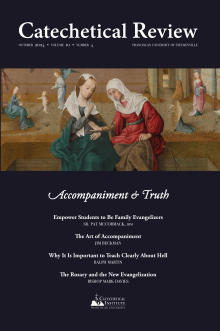Accompaniment has been a popular topic in catechesis for the past several years, and rightfully so. The Directory for Catechesis lists “accompanier” as one of the primary roles of the catechist, adding, “the catechist is an expert in the art of accompaniment.”[1] In his apostolic exhortation Evangelii Gaudium (“The Joy of the Gospel”), Pope Francis defines accompaniment as a process of walking with the other, listening, and leading others “ever closer to God.”[2] The image of walking together is a particularly salient one as we think about children’s catechesis, since children (especially young children) often literally walk hand-in-hand with an adult in most places, especially unfamiliar ones. We walk with children for a variety of reasons: we want to make sure they go in the right direction and don’t get lost along the way; we want them to feel safe; we want to make sure they don’t miss things that will form them and excite their imaginations. But most of all, we walk with children because we love them, and we know that people grow best when that growth occurs in the context of relationship.
Getting to Know You
How can catechists of children walk with young people in a spiritual sense as they are formed in the faith? One way is by getting to know our learners. Look for resources on the cognitive, social, moral, and spiritual development of children in the age group you teach. This information, which can sometimes be found in the catechist manual accompanying a religious education curriculum, can offer a starting point for understanding the thinking and developmental needs of your learners.
Even as we understand what’s typical for children at a particular age, it’s important to remember that every child is different and to get to know the individual child. Listening to the individual experiences, hopes, dreams, and interests of our learners can help us present the faith as relevant to their lives. It might be helpful to begin each session with icebreaker questions or games that allow learners to share something about themselves and their interests. Think of questions that begin with phrases like, “Tell about a time when you . . .” or “What is your favorite . . .” In today’s hectic and noisy world, too often we fail to take time with one another, to listen without worrying about what we will say next. Accompanying children means sitting with them, listening to the words they speak, and reflecting on the feelings behind the words. It means recognizing what a gift we are being given when little ones trust us with their stories. It means being present to children as a reminder that God is present with them.
The rest of this online article is available for current Guild members.
[1] Pontifical Council for the Promotion of the New Evangelization, Directory for Catechesis (Washington, DC: United States Conference of Catholic Bishops, 2020), no. 113.
[2] Pope Francis, Evangelii Gaudium, no. 170.
[3] Ibid., no. 171.
This article originally appeared on pages 63-67 of the print edition.
Art Credit: Catechesis of the Good Shepherd, Flickr.com CC.
This article is from The Catechetical Review (Online Edition ISSN 2379-6324) and may be copied for catechetical purposes only. It may not be reprinted in another published work without the permission of The Catechetical Review by contacting [email protected]



















